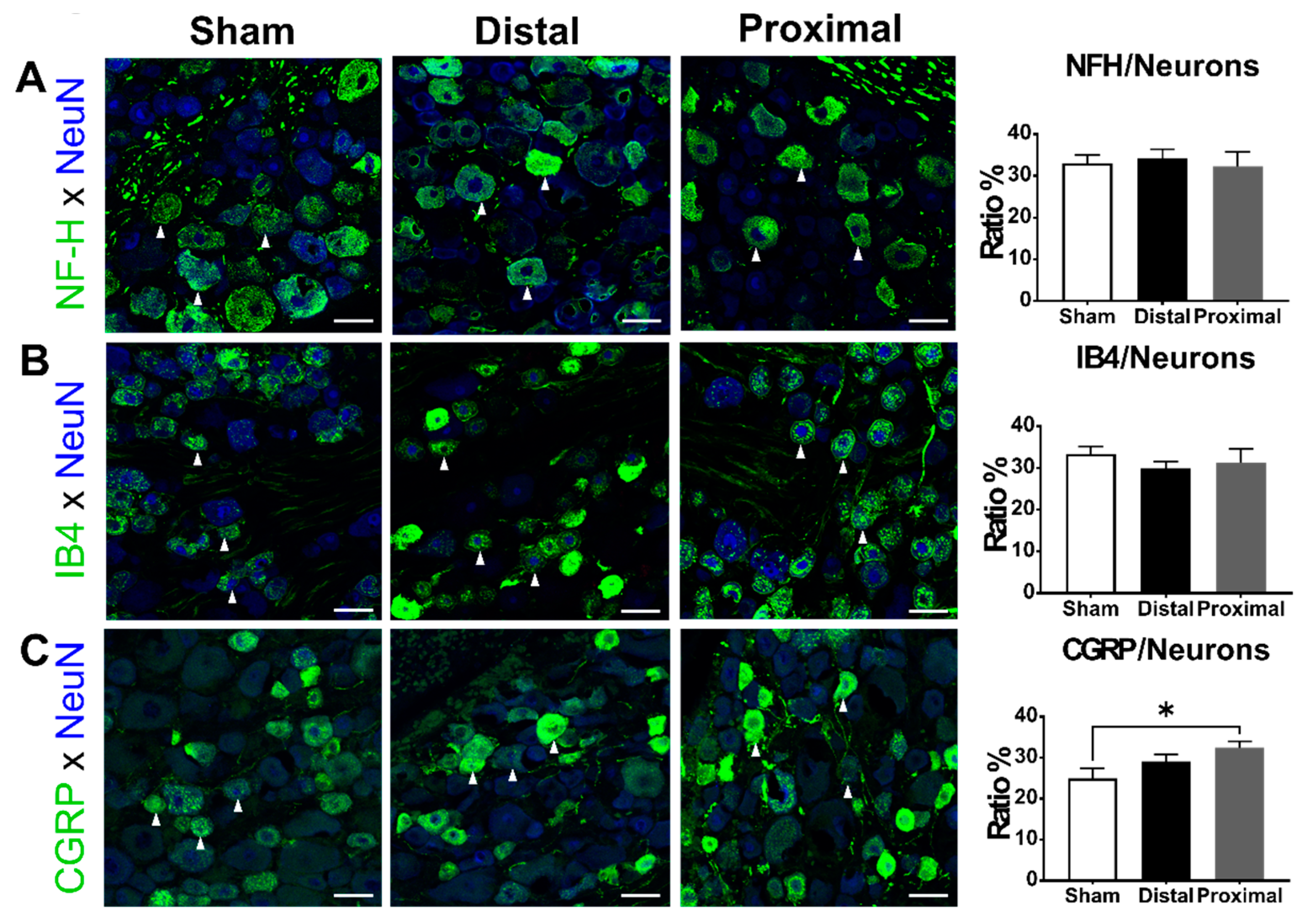Correction: Lin et al. ATF3-Expressing Large-Diameter Sensory Afferents at Acute Stage as Bio-Signatures of Persistent Pain Associated with Lumbar Radiculopathy. Cells 2021, 10, 992
Error in Figures
Correction to Results Sections 3.3 and 3.4
3.3. The Ratios of ATF3-Positive DRG Neurons Increased Significantly After Nerve Constriction Distal to DRG Than After Nerve Constriction Proximal to DRG
3.4. The Ratios of CGRP-Positive DRG Neurons Increased 1 Day After Proximal Nerve Constriction
Reference
- Lin, J.-H.; Yu, Y.-W.; Chuang, Y.-C.; Lee, C.-H.; Chen, C.-C. ATF3-Expressing Large-Diameter Sensory Afferents at Acute Stage as Bio-Signatures of Persistent Pain Associated with Lumbar Radiculopathy. Cells 2021, 10, 992. [Google Scholar] [CrossRef] [PubMed]


Disclaimer/Publisher’s Note: The statements, opinions and data contained in all publications are solely those of the individual author(s) and contributor(s) and not of MDPI and/or the editor(s). MDPI and/or the editor(s) disclaim responsibility for any injury to people or property resulting from any ideas, methods, instructions or products referred to in the content. |
© 2024 by the authors. Licensee MDPI, Basel, Switzerland. This article is an open access article distributed under the terms and conditions of the Creative Commons Attribution (CC BY) license (https://creativecommons.org/licenses/by/4.0/).
Share and Cite
Lin, J.-H.; Yu, Y.-W.; Chuang, Y.-C.; Lee, C.-H.; Chen, C.-C. Correction: Lin et al. ATF3-Expressing Large-Diameter Sensory Afferents at Acute Stage as Bio-Signatures of Persistent Pain Associated with Lumbar Radiculopathy. Cells 2021, 10, 992. Cells 2024, 13, 2061. https://doi.org/10.3390/cells13242061
Lin J-H, Yu Y-W, Chuang Y-C, Lee C-H, Chen C-C. Correction: Lin et al. ATF3-Expressing Large-Diameter Sensory Afferents at Acute Stage as Bio-Signatures of Persistent Pain Associated with Lumbar Radiculopathy. Cells 2021, 10, 992. Cells. 2024; 13(24):2061. https://doi.org/10.3390/cells13242061
Chicago/Turabian StyleLin, Jiann-Her, Yu-Wen Yu, Yu-Chia Chuang, Cheng-Han Lee, and Chih-Cheng Chen. 2024. "Correction: Lin et al. ATF3-Expressing Large-Diameter Sensory Afferents at Acute Stage as Bio-Signatures of Persistent Pain Associated with Lumbar Radiculopathy. Cells 2021, 10, 992" Cells 13, no. 24: 2061. https://doi.org/10.3390/cells13242061
APA StyleLin, J.-H., Yu, Y.-W., Chuang, Y.-C., Lee, C.-H., & Chen, C.-C. (2024). Correction: Lin et al. ATF3-Expressing Large-Diameter Sensory Afferents at Acute Stage as Bio-Signatures of Persistent Pain Associated with Lumbar Radiculopathy. Cells 2021, 10, 992. Cells, 13(24), 2061. https://doi.org/10.3390/cells13242061





